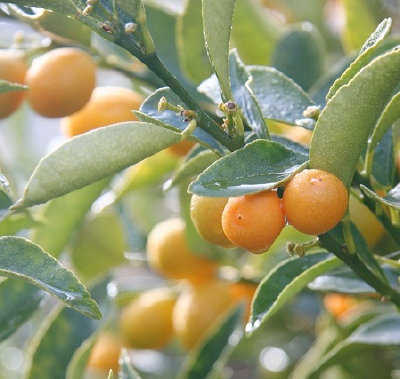By Urban Harvest

In over 29 years as a garden designer in the Houston area, I have had the opportunity to design a wide variety of garden styles, including formal gardens, contemporary gardens, cottage gardens, habitat gardens and more.
I design in response to my client's goals for their outdoor living space, which has often included carving out a small portion of the space as a kitchen garden, an area for the production of fresh herbs, vegetables and cut flowers. With recent food security scares and emergence of the locavore movement (those who commit to eat as much locally produced food as possible), the request for a kitchen garden has almost become routine.
Recently, I have found people wanting edible gardens, but not the typical isolated area of raised beds between gravel paths, but rather a more typical ornamental garden that replaces some or all of the ornamental plantings with edible ones. And why not? Many edible plants create beautiful floral displays as well as provide foliage color and texture that is unequaled in the ornamental palette.
A number of fruits, vegetables, and herbs can be incorporated into your garden without making it look like vegetable patch. Consider using them in a few areas to replace a patch of tired, old groundcover like liriope.
In the warm season sow bush beans, spicy globe basil, arugula or small varieties of watermelon or cantaloupe as summer groundcovers. Herbs such as prostrate rosemary, lemon balm, thyme or mint (sometimes a little too well) provide evergreen groundcover given our mild Houston winters.
Chives or multiplying onions offer a spiky texture for yearlong accent in the garden. In addition to the onions and chives, the flowers of these plants add a delicate zest to many foods.
In the cool season leaf lettuces, greens, radishes and carrots provide a lush groundcover alternative and are easily seeded. Heirloom lettuce varieties such as Red Sails, Freckles, Green Deer Tongue and Oak Leaf offer a wide variety of color and texture. The colors of bright lights chard are so vibrant that it is often used in ornamental, seasonal color plantings.
Crops that climb by their nature such as pole beans, peas, cucumbers and squash offer an edible alternative to ornamental vines and can be grown on trellises or trained to green a blank wall or fence.
If you've experienced ornamental vines that threaten to overtake your home without constant pruning, you'll appreciate edibles vines that reach maturity in one season, can be removed after fruiting, and then be replaced with the next season's crop. It beats hauling fig ivy clippings to the compost pile every other week.
Blackberries and raspberries provide a permanent option for vertical gardening. They will tolerate some shade and they display brilliant fall color.
Fruit trees can be added to any sunny spot in the garden. Apples, pears, pomegranates, figs, and persimmons are a few fruits that produce very well in our area with little care. We now grow many tropical fruit trees in our area that lend an exotic character to the garden.
If your garden has limited space, espaliered fruit trees offer the answer to the problem. An espalier is a tree or shrub that is grown flat against a wall. Most fruit trees are sold as bare root plants in January and their pliable young branches are easily pinned to a wall. Containerized fruit trees can sometimes be found in local nurseries, but make sure they are varieties that perform well in the area where you live.
Your best bet is to purchase fruit trees at the annual Urban Harvest Fruit Tree Sale -- the next one is January 14th, 2017, so check out their website www.urbanharvest.org.
Citrus trees are easy care as well, but some types need more winter protection than others may. Mexican limes are the least hardy while kumquats and Satsuma oranges are the most hardy, withstanding temperatures in the low 20s.
Citrus blossoms impart a delicate fragrance to the garden and attract the Giant Swallowtail Butterfly. They are small evergreen trees, perfectly suited as screen or shade trees in urban gardens, and they provide an excellent habitat for songbirds.
You may not realize it, but some fruits of traditionally ornamental plants are edible and quite tasty. Pineapple guava, which displays beautiful blue-green foliage, is often used as a hedge or small tree and produces a striking bloom whose petals add a tropical taste to salads. The fruit, not a true guava, has a light tropical taste.
Many antique roses produce fruit known as hips. Pound for pound they contain more vitamin C than oranges and are great for jellies and teas.
Barbados cherry blooms with a delicate pink flower almost all year and produces a small edible fruit that brightens up a salad.
Elaeagnus is a large shrub often used as a background plant for its light, silver-green foliage. Its inconspicuous fall bloom fills the garden with fragrance and produces a small (almost all seed) fruit that is often used for jelly.
Hyacinth bean vine is commonly used as an ornamental vine. The foliage has a purple cast and it and has a continuous display of lavender flowers during the warm season. The beans in its highly ornamental, deep purple pods are actually edible.
Some commonly used annuals provide edible flowers such as pansies, violas, nasturtiums and calendula in the cool season and marigolds through the summer.
These are only a few suggestions for replacing traditional ornamentals with something that could double as dinner. Examine your garden with a fresh eye to discover areas ripe for changing into edible producing pockets.
This article is provided by Urban Harvest, Inc. To learn about gardening classes, farmers markets, school and community gardens and more go to www.urbanharvest.org or call 713-880-5540 for more information. This article was written by Suzy Fischer, who is a registered landscape architect and principal of Fischer Schalles, a landscape design/build firm.